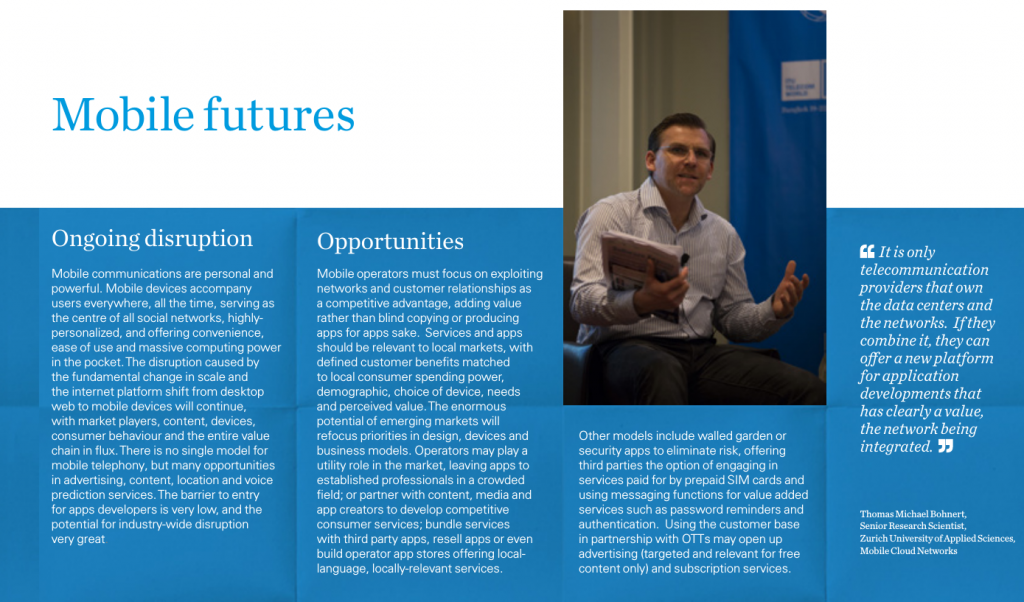IEEE GLOBAL COMMUNICATIONS CONFERENCE (IEEE GLOBECOM) is one of the flagship conferences of the IEEE Communications Society and high up on my annual conference must-attends.
This year, IEEE Globecom 2010, is held in Miami, Florida and lines-up seamlessly in the hall of fame of this conference series. With 2500 attendees on-site it sets a new record and as usual it features a very comprehensive program with a good number of high-profile speakers from business as well as academia.
Keynote by Yoshihiro Obata, CTO of eAccess Ltd in Japan
A very interesting talk, excellent presentation with a very good mix of industry/company background/insight and technological/research challenges. This is the style of talks you look for at IEEE Globecom.
Here is what Mr Obata had to tell:
– Traditionally, Telco services were controlled by operators (e.g. SMS). With IP services control moves towards devices/applications
– And terminal are no any longer provided by the operator, huge variety in devices, competition high (e.g. Apple vs Google)
– Smart-phones turn signaling (traffic) into a huge issue for operators. As control went from network to devices operators cant control / police users effectively. This essentially prevents M2M introduction
– Highest expenses are still with the backbone, eAccess flat rate offers were only possible since they own a backbone, especially in wireless networks is the backbone cost what matters; base stations are not relatively inexpensive
– Volume and characteristic of traffic by corporate users does not cause trouble, i.e. corporate users behave as they follow a certain (manageable) pattern (e.g. peak traffic).
– Mobile vs Fixed: The peak (busy hour) in mobile networks is broad (TMB: statistically stationary) versus traffic in fixed networks (ie DSL) shows very sharp/short peaks (instationary) -> TMB: This has consequences to admission control!
– Reasoning: mobile terminals/services are simpler to use, by potentially more singles and younger users, which are attached for longer periods to their terminals; In contrast, Internet services over fixed (cable, DSL, etc) access require a greater effort to start, in particular the terminal (PC, laptop, etc) and hence users start-use-shut.
– On traffic patterns: 300K (2-5%) users take 50% of the capacity for peer-to-peer traffic, still no issue for state-of-the-art technlogy, annoying though, but the network needs to be sized for full capacity anyways.
– On business in general, telcos need to adapt to change as meanwhile nearly 30% of the user spending goes to the terminal and this takes a major part of the overall budget
– A new service in Japan is „Pocket WiFi, WiFi allows terminals to concurrently access the network with one subscription. This gives meanwhile three options for mobile operators – hotspots, mirco cells, pocket wifi – still unclear which will predominate
Kevin Fall (Intel) WSN Forum
– Observation on WSNs – mostly worried with power consumption, use essentially the same network architecture as any other devices, people mostly use them for trivial scenarios (room temperature monitoring)
– Programming WSNs as essembles instead can be a basis for innovative scenarios
– Issues: disconnection, addressing (location/ID, address space)
– Some ideas/solutions: DTN (storage/caching), use URIs for addressing/naming anything
– Info-networking (content-centric or data-centric networking) that put data/information in the center of design, architecture, operations instead of hosts
Edward Knightly (Rice Uni) WSN Forum
Edward, how was giving a keynote at my BWA workshop in 2008, talked about „sensing“ in general and took WSNs into the vehicular, smart grid, and eHealth domain. Nothing really new, some of the slides are indeed known for a while (eHealth). What was new though, is that he is promoting „Visible Light Communication“ as a technology for vehicular communications.
H. Atarashi (NTT DOCOMO) 4G Operator Perspectives
– DOCOMO to deploy LTE comercially in Dec 2010, initially over legacy 3G infrastructure, terminals will support dual-mode
– 3 deployment scenarios, remote-radio-head, cabinet-type, indoor
– Remote radio head: base stations (eNodeB) are deployed somewhere and connect over fiber to the …
– ~1000BS by end of 2010, 5000 by end of 2011, 15000 by end of 2012 (40% POP coverage)
China Mobile
– 564m subscribers, ~500000 GSM base stations
– LTE deployment in 2011, several trials conducted with several manufacturers involved (terminal + network), LTE-TD meets all expectations
COMCAST IPv6 Forum
– CDNs are starting migration strategies this year (2011)
– Mind that this involves many aspects, way beyond the network, e.g. OS, Apps, OSS tools, CRM, Accounting, BSS in general
– To wait is a risk: v6 introduction takes time, Google needed 3 years
– And there will be more NAT to come in the meantime
– But 90% of v6-readiness can be achieved without turning v6 on!
– How to save cost? Put v6-readiness in your product strategy (TMB: that“s easy said ..) and mind that a customer may need to turn NAT on in order to access your content
– But isn“t v6 broken? No, that“s mostly an issue on your consumer-side and mind, ISP-NAT does not scale and add complexity/unwanted control
– The today challenge of v6 is not so much technology, it“s training of field personell, sales, support, etc
– Comcast is virtually v6 ready
Nokia IPv6 Forum
– Symbian is v6 ready since quite a while
– NAT versus v6, keep-alive versus idle but connected -> NAT drains your mobile“s battery
– Operators will not switch on Voice over LTE in the near future
– More details on NAT: keep-alive commonly in 40sec-5min intervals, can decrease your standby time from days to hours, many different/imcompatible tunneling, very different NATs (home, office, hotspots, ISP-NAT, etc) in terms of traversal mechanisms, frequently poor quality code, mind multi-level NAT (cascades)
– T-Mobile and Nokia run v6-trial in the USA, Nokia supports cell+wifi v6 in the N900 dual-stack.
Some random notes
– JND theory, „just noticable distortion“, widely used theory for picture quality evaluation (subjective)
– Wireless network usage is not uniform, one practical example shows 15% of the cells generate 50% of total traffic
– Most of the traffic in the future is expected to come from indoor environments






